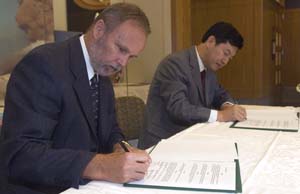The Department of Earth and Planetary Sciences in Arts & Sciences and the Chinese Academy of Geological Sciences (CAGS) have signed a research agreement that will involve collaboration on a number of research thrusts, travel between the two institutions, and eventually student exchanges that could lead to some Chinese students attaining doctorates from Washington University in St. Louis.
The agreement was signed Sept. 18 at a ceremony and reception held on the third floor of the Earth and Planetary Sciences building.

“This is an exciting time for our two institutions as we collaborate on some key research areas,” said Raymond E. Arvidson, Ph.D., James S. McDonnell Distinguished University Professor, and chair of earth and planetary sciences. “We’re ready to get started and eagerly anticipate student exchanges in the future, in addition to the research projects.”
“This agreement is symbolic of a new friendship and new discoveries that we will find with each other’s help,” said Dong Shuwen, Ph.D., vice president of the Chinese Academy of Geological Sciences, who signed the agreement along with Arvidson.
One of the key thrusts of the agreement is the dating of lunar samples from the Apollo missions that are held here at Washington University with a rare (only nine in the world), powerful instrument called the SHRIMP II (or Sensitive High Resolution Ion Microprobe, second generation, housed at the Chinese Academy of Geological Sciences in Beijing. The SHRIMP II is a high precision Secondary Ion Mass Spectrometer (SIMS). Ion microprobes make in situ isotopic and chemical ‘surface’ analyses of solid targets by bombarding the sample with an ion beam with a diameter of several micrometers.
Collaborations between WUSTL and the Academy will involve employing the SHRIMP II to date lunar samples to gain a better understanding of the Moon’s geologic history. Bradley Jolliff, Ph.D., research associate professor of earth and planetary sciences, will be working with Dunyi Liu, Ph.D., and others of the Academy on the Apollo samples. They will also use the SHRIMP to date lunar meteorites that the Washington University group studies. Randy Korotev, Ph.D., research associate professor, and Ryan Zeigler, Ph.D., research scientist, also in earth and planetary sciences, will work with Jolliff and the new Chinese collaborators on the lunar sample studies.
WUSTL planetary scientists will assist Academy researchers in remote sensing data analysis from the Chinese lunar probe project, Chang’E-1, set to be launched next month.
Collaborators will study the evaporative deposits from high-altitude saline lakes and from the weathering belts of sulfide zones of the Tibetan-Qinghai Plateau, a cold and dry geological setting similar to Mars. Alian Wang, Ph.D., senior research scientist in earth and planetary sciences, will work on that project, in collaboration with academician Zheng Mianping at CAGS. David Fike, Ph.D., will join the collaboration after the beginning of his WUSTL appointment as an assistant in January 2009.
An Meijian, Ph.D., a geologist from the Academy, will collaborate with WUSTL professor of earth and planetary sciences Douglas A. Wiens, Ph.D., on the seismology of Antarctica. In late November, Wiens and a team will go to remote regions of Antarctica to place seismographs in both east and west Antarctica, hopefully to learn something about the Earth’s crust and mantle beneath the continent and whether the continent might be thawing, and to glean information about glaciers, mountains, and ice streams.
A fifth area of collaboration is the isotopic analysis of meteorites. WUSTL participants are Frank Podosek, Ph.D., professor of earth and planetary sciences, and Frederic Moynier, Ph.D., who will start as an assistant professor in January 2008. THE CAGS participant will be Zhu Xiangkun, Ph.D.